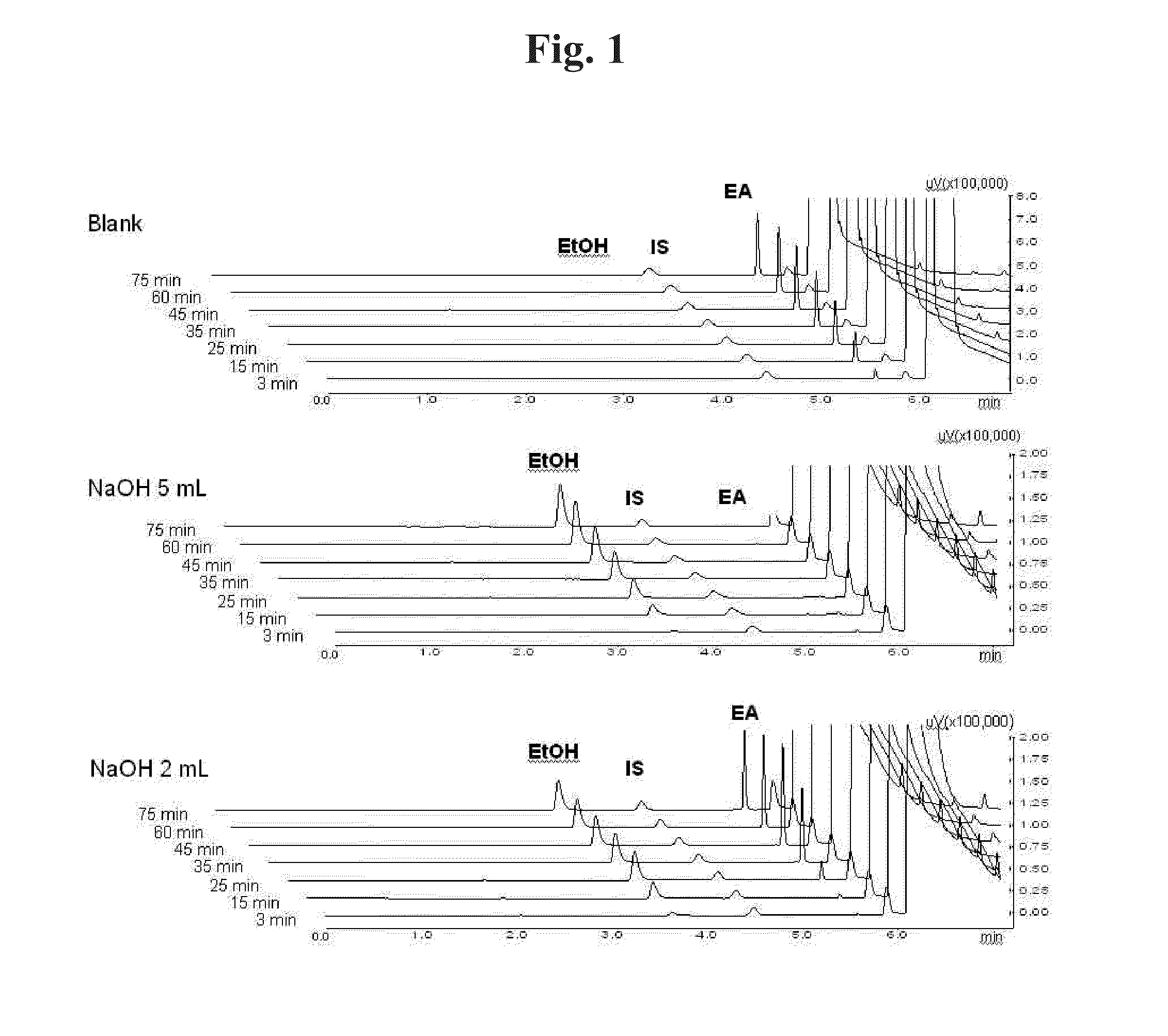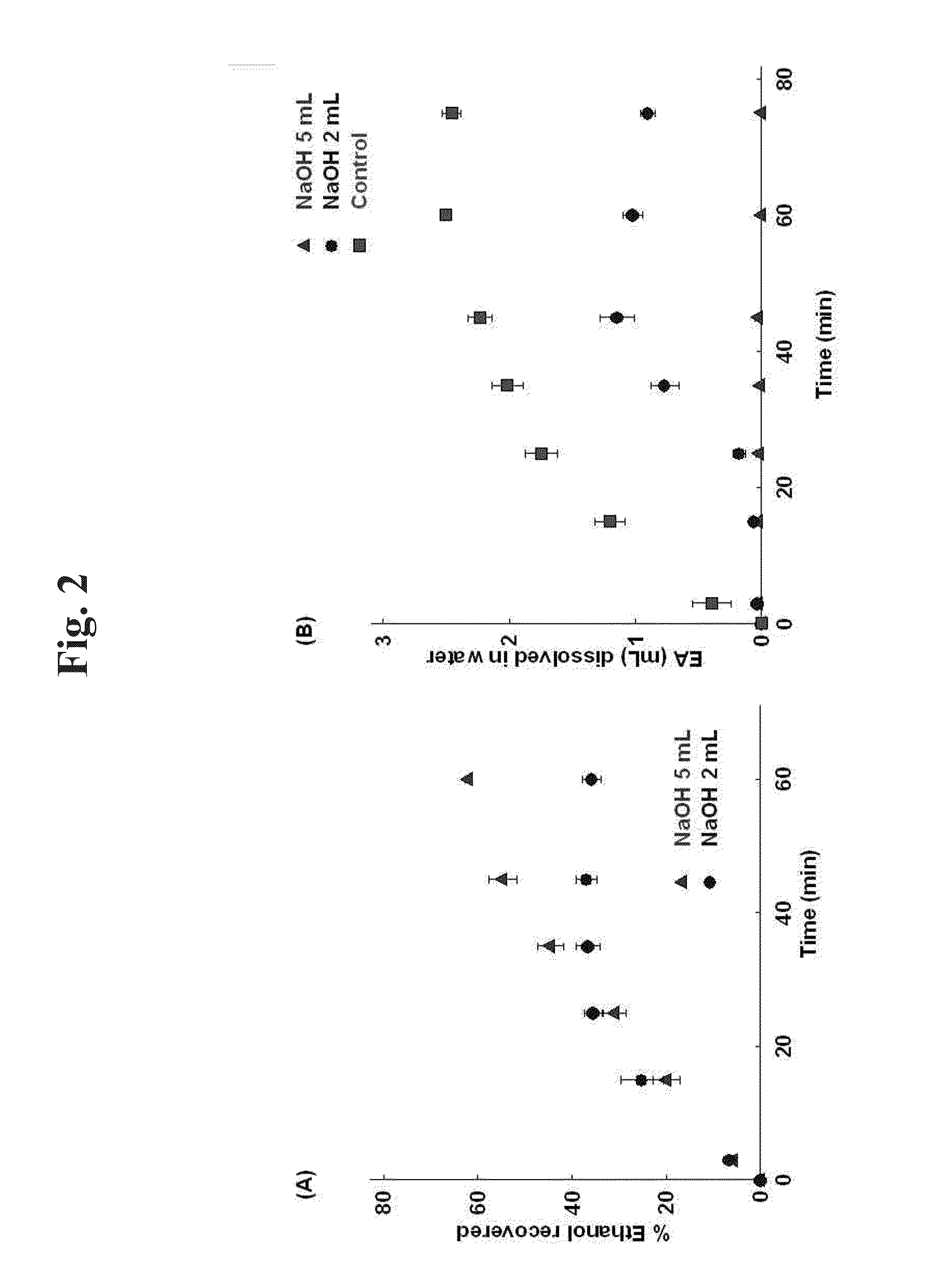Method for preparing microspheres and microspheres produced thereby
a technology of microspheres and microspheres, which is applied in the direction of biocide, anti-inflammatory agents, drug compositions, etc., can solve the problems of increased human skin cancer, increased temperature, and excessive use of water, and achieves the effect of simple and easy way
- Summary
- Abstract
- Description
- Claims
- Application Information
AI Technical Summary
Benefits of technology
Problems solved by technology
Method used
Image
Examples
example
Example 1
Removal of Organic Solvent (Ethyl Acetate) Using Acid or Base
[0107]It was investigated whether ethyl acetate is decomposed and removed by an acid or a base. When ethyl acetate is decomposed by an acid or a base, water-soluble ethanol and acetic acid are produced. Therefore, concentrations of ethyl acetate and ethanol in the aqueous solution were quantitated by gas chromatography (GC).
[0108]40 mL of 0.5% polyvinyl alcohol (PVA) aqueous solution was added to a beaker. After adding 2 mL or 5 mL of 10 M NaOH or 10 M HCl (0 mL for the blank), 4 mL of ethyl acetate was added along the wall. While stirring such that the two phases are not completely mixed, each 200 of sample was taken from the aqueous phase at 3, 15, 25, 35, 45, 60 and 75 minutes for GC analysis.
[0109]GC analysis was performed with GC-2010 (Shimadzu, Japan). Zebron ZB-624 (Phenomenex, USA) analysis column using 6%-cyanopropylphenyl-94%-methylpolysiloxane as stationary phase was used. The quantity of ethyl acetate,...
example 2
Removal of Organic Solvent (Ethyl Formate) Using Acid or Base
[0113]It was investigated whether ethyl formate is decomposed and removed by an acid or a base. When ethyl formate is decomposed by an acid or a base, water-soluble ethanol and formic acid are produced. Therefore, concentrations of ethyl formate and ethanol in the aqueous solution were quantitated by gas chromatography (GC).
[0114]40 mL of 0.5% polyvinyl alcohol(PVA) aqueous solution was added to a beaker. After adding 2 mL or 6 mL of 10 M NaOH or 10 M HCl (0 mL for the blank), 4 mL of ethyl formate was added along the wall. Stirring was performed such that the two phases are not completely mixed, so that some of ethyl formate diffused into the aqueous phase. Each 200 of sample was taken from the aqueous phase at 5, 10, 15, 20, 30, 45 and 60 minutes for GC analysis.
[0115]GC analysis was performed with GC-2010 (Shimadzu, Japan). Zebron ZB-624 (Phenomenex, USA) analysis column using 6%-cyanopropylphenyl-94%-methylpolysiloxane...
example 3
Removal of Organic Solvent (Propyl Formate) Using Acid or Base
[0119]It was investigated whether propyl formate is decomposed and removed by an acid or a base. When ethyl formate is decomposed by an acid or a base, water-soluble propanol and formic acid are produced. Therefore, concentrations of propyl formate and propanol in the aqueous solution were quantitated by gas chromatography (GC).
[0120]40 mL of 0.5% polyvinyl alcohol(PVA) aqueous solution was added to a beaker. After adding 2 mL or 6 mL of 10 M NaOH or 10 M HCl (0 mL for the blank), 4 mL of propyl formate was added along the wall. Stirring was performed such that the two phases are not completely mixed, so that some of ethyl formate diffused into the aqueous phase. Each 200 of sample was taken from the aqueous phase at 5, 10, 15, 20, 30, 45, 60, 85, 120 and 160 minutes for GC analysis.
[0121]GC analysis was performed with GC-2010 (Shimadzu, Japan). Zebron ZB-624 (Phenomenex, USA) analysis column using 6%-cyanopropylphenyl-94...
PUM
| Property | Measurement | Unit |
|---|---|---|
| boiling point | aaaaa | aaaaa |
| boiling point | aaaaa | aaaaa |
| particle size | aaaaa | aaaaa |
Abstract
Description
Claims
Application Information
 Login to View More
Login to View More - R&D
- Intellectual Property
- Life Sciences
- Materials
- Tech Scout
- Unparalleled Data Quality
- Higher Quality Content
- 60% Fewer Hallucinations
Browse by: Latest US Patents, China's latest patents, Technical Efficacy Thesaurus, Application Domain, Technology Topic, Popular Technical Reports.
© 2025 PatSnap. All rights reserved.Legal|Privacy policy|Modern Slavery Act Transparency Statement|Sitemap|About US| Contact US: help@patsnap.com



